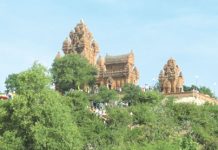|
Hundreds of people including children attended the setting up of a cay neu (new year’s tree) made from bamboo in the grounds of the Viet Nam Museum of Ethnology on Feb 3 to herald the start of the Tet holiday.
|
| The traditional tree custom occurs on the 23rd of the last lunar month, the day of Ong Cong (Land Genie) and Ong Tao (Kitchen God) but until recently very few young people knew about it. Researchers were on hand to explain the ritual.
In Vietnamese tradition, Ong Cong and Ong Tao were popular genies. People believed that on the day, the genies went to Heaven to brief the Jade Emperor on the life of the owner of the house they occupied, and to pray for luck, prosperity and happiness for all members of the household. On New Year’s Eve, both genies returned to earth and resumed their caretaking duties in the kitchen of the house. Prof Ngo Duc Thinh, director of the Viet Nam Belief Culture Research and Preservation Centre in Ha Noi, said people made offerings to the genies to see them on their way to Heaven. They erected the new year’s tree as a symbol for safety, to drive evil away while the genie guardians were absent. “A long time ago, people put a new year’s tree in front of their houses on the 23rd day of Lunar December and lowered it on the 7th of Lunar January but the custom has been neglected in many regions due to changes in lifestyle,” he said. “The tree is considered a bridge for the gods and forefathers’ spirits to travel between Heaven and Earth. Nowadays people are likely to display a kumquat or peach blossom tree to decorate the house and decrease the spiritual complication.” People hung different objects on top of the cay neu, depending on their region. The new year’s tree set up at the museum yesterday by Nguyen Van Doan, from the northern province of Bac Ninh, has a bamboo basket containing seeds which are meant to bring prosperity. There’s also a paper carp which the gods can ride to Heaven; a lantern to light the way for the spirits of the forefathers to visit the home at Tet; terracotta bells that sound out against evil. “Raising cay neu during Tet is an important part of the Vietnamese belief and custom, it is the way to commemorate our origins, but regretfully it’s rare to see cay neu at people’s houses nowadays,” Doan said. “I appreciated being invited to the cay neu ceremony at the museum. It’s a good chance for people, especially the younger generation, to learn about the ritual.” Researcher Nguyen Ngoc Thuat, from the central province of Thanh Hoa, pointed out similarities and differences in the tree tradition in different regions. “In my homeland, people hang a basket of cereal on the top of the tree and instead of bells, they hang hoops made from feathers of a cock’s tail to turn away evil spirits,” Thuat said. “The number of hoops depends on the gender of the house’s owner. If a woman owns the house, nine hoops are hung, but if it’s a man, its seven hoops.” The Land Genie and Kitchen God rituals mark the beginning of a series of cultural activities at the museum, such as the making of banh chung (glutinous square cake), to he (toy figurines) and folk paintings to decorate the house. The museum programme on February 15-17 will include activities such as traditional music performances, folk games and a food fair. The museum is co-operating with the northern province of Yen Bai’s Department of Culture to introduce the Mong’s thang co (a braised dish of horse, goat or buffalo meat) and the Thai’s five-colour glutinous rice as well as traditional performing arts of the ethnic groups in the province. Nose flute player Dang Thi Thanh, of the Xa Pho ethnic group, will play and teach the art. Source: VNS |
Welcome!Log into your account
















